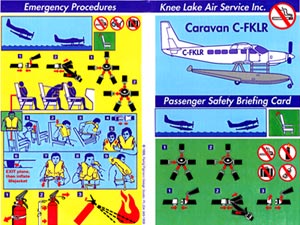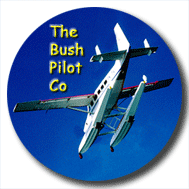The Safety Features Card:
How to Insure Your Cards Are Both Legal and Effective.
![]()
"Safety
Information Shall be Depicted in a Clear and Distinct Manner"
![]()

The second part is that the briefing must point out:
(v) the location, purpose of,
and advisability of reading the safety features
card;
The regulations also state that:
(3) The safety information provided by the card shall:(a) be accurate for the aeroplane type and configuration in which it
is carried and in respect of the equipment carried;
(b) be presented with clear separation between each instructional
procedure. All actions required to complete a multi-action
procedure to be presented in correct sequence and the sequence of
actions to be clearly identified; and
(c) be depicted in a clear and distinct manner.
 Nowhere,
however, does it state that the Safety Features Card must be depicted with
pictorial or diagram representation and must be understandable by
non-English, or non-French speaking passengers. And yet, just try to get a
Passenger Safety Features Card approved by Transport Canada unless it
meets those very requirements. The fussy inspector who makes you redo your
highly specialized safety features cards over and over until it is
correct, however, is doing the right thing in meeting the above
regulation.
Nowhere,
however, does it state that the Safety Features Card must be depicted with
pictorial or diagram representation and must be understandable by
non-English, or non-French speaking passengers. And yet, just try to get a
Passenger Safety Features Card approved by Transport Canada unless it
meets those very requirements. The fussy inspector who makes you redo your
highly specialized safety features cards over and over until it is
correct, however, is doing the right thing in meeting the above
regulation.
A pictorial or diagram based safety features
card should be clearly and distinctly understood by almost anyone anywhere
in the world. Meeting those criteria, however, is not easy especially
since much of those requirements are highly subjective. What may be clear
to one inspector may not be so clear to another.
The route to having proper and legal safety
features cards, however, is much easier now with the advent of modern
computers and desktop publishing. The idea of making revising and updating
the pictorial cards is still a daunting task, considering the details that
must be correct in order to get the cards approved and re-approved.
Take the little detail of depicting a mother
holding her infant in her arms and assuming the correct brace position for
an emergency landing. What position will she assume if the seat does not
have a shoulder harness, and what position will she assume if the seat is
equipped with a shoulder harness, and what position will she assume if the
airline provides supplementary infant restraining harnesses? I don’t
know if anyone makes supplementary infant restraining harnesses, but what
if they did? How would you depict the correct brace position?
The regulation also makes keeping your cards
legal more difficult, but ultimately more practical, by insisting that the
cards must be aircraft specific. Even if two aircraft are the same type
does not mean they are of the same configuration. On one operation we had
six amphib Caravans and 3 different configurations. Keeping the correct
safety features cards in the correct aircraft became a constant problem
and we finally had to mark each card with the aircraft registration to
insure we had the right card for each aircraft.
And then we changed the seating
configuration on all the Caravans. What a nightmare. It was easy to change
the seats in the Caravan. I could change the seats myself between flights,
but it took a week in house to make up the new safety features cards and
another week to get them approved.
That is where The Bush Pilot Company can
help. We provide a ready-made service for all types of bush aircraft,
including helicopters and many commuter aircraft as well. The cards are
made up according to the Canadian Aviation Regulations and proven by
having been approved by Transport Canada Inspectors. Moreover, we are
familiar with ICAO, FAR, CAA, and many other regulations worldwide and can
make up cards to meet your requirements.
We will revise any of the Safety Features
Cards to conform to your exact aircraft type and configuration and either
have it pre-approved by our local Transport Canada Inspector, or
coordinate the approval with your local CAA. If necessary, and I would
recommend it, we can mark each card with the type and registration of each
specific aircraft.
More importantly, we will keep all your
cards for all your aircraft on file and if you need more or if your
requirements have changed then we can easily print more or quickly update
your cards and ship them out to you with the minimum amount of delay.
Our Safety Features Cards are printed in
distinctive colours to insure readability and are laminated for endurance.
For most aircraft the cards are specifically designed to fold for easy
storage in restricted seat back pockets, and to still be completely
readable once opened.
Article by John S Goulet
To obtain a quote based on your aviation requirements
Click Here to Calculate Your Costs
and then submit for a full quotation.
![]()
We do Helicopters as well. Click here for sample.
![]()
The attitude indicator will guide you back to The Bush Pilot Company.
 Top of this story.
Top of this story.
Last modified on
March 05, 2006 .
© Virtual Horizons, 1996.